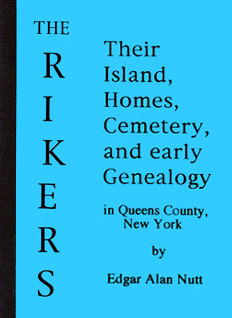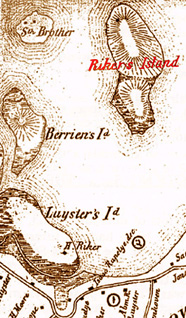
 | Part #3 of 12 (so far): NYCHS presents excerpts from The Rikers: Their Island, Homes, Cemetery and Early Genealogy in Queens County, NY by permission of its author, an 11th generation Abraham Rijcken vanLent descendant, Edgar Alan Nutt. |  |
|
If the name of the father of the brothers Rijcken vanLent were known, or if
the relevance to them of the vanLent designation were known as a certainty, then
the status of the Rijcken name, whether it was a patronym or a surname, would be
resolved. Since neither is the case the status of the Rijcken name can only be a
matter of speculation based upon whatever data are available.
Various Netherlands
archives and other records include references to a multitude of Rijcken individuals a
very large percentage of whom are associated with dates from the the latter part of
the seventeenth century and later. By the end of that century in the Netherlands as
well as in colonial America the name is well-established as a surname, hence
records from the earlier period are the relevant ones, and they, as noted above, are
the rarer ones. Most relevant are those from the time of Abrahamís emigration from
his native country and earlier, i.e. from no later than about 1638.
Several writers have stated dogmatically that in Abrahamís case Rijcken was a
patronymic name such that his father was Rijck or some other form of the Dutch
version of Richard, and the sole bit of supporting evidence that has been cited is the
fact that Abraham named his eldest son Ryck. . . .
It is perfectly clear that Rijcken in some instances was a patronym. The
earlier discussed case of Ryck Hendrickszen whose son was Hendrick Rycken it a
perfect American example of Rycken as a patronym which in snhsequent
generations was carried as an established surname. . . .
It is apparent that in the vartous matters of interest relating to immigrant
Abraham Rycken and his immediate preceding and succeeding generations there is
little certainty and more is unknown than is known. Nevertheless available evidence
together with reasonability allow for some conclusions of varying firmness and
consistency, as follow:
Photo by NYCHS during the June 5, 2005 tour given by Marion Smith to benefit the Queens Historical Society. Tour images do not appear in Edgar Alan Nutt's 2004 book and have been added to the web version by NYCHS. Click image to visit the Queens Historical Society web site. No. 1 -- Jacob Simonsz deRycke
Holy Roman Emperor Charles V, grandson of Emperor Maximilian 1 and of
Ferdinand and Isabella of Spain, inherited title to the Netherland provinces when his
father Philip 1 of Castille died in 1506 and became King of Spain upon Ferdinandís
death in 1516. For the next four decades he was embroiled in a long series of political
and religious conflicts with his fortunes of power and control waxing and waning.
Before retiring in 1557 he gave his hereditary title to the Netherlands to his son
Philip and abdicated as king of Spain in favor of his son as Philip II who henceforth
was considered a foreign overlord by Netherlanders. Resentful at the House of
Hapsburgs feudal and absolutist Spanish tyranny and religious persecution, open
rebellion commenced in 1568, and in a few years independence from Spain was
declared.
The war was finally concluded in 1643 with the Truce of Westphalia, but it
was effectively ended with the Twelve Yearsí Truce of 1609, brought about in large
part by the exploits against Philipís navy by Dutch admirals with whom Jacob
Simonsz deRycke was first a captain and later an admiral himself.
When the Duke of Alba, the ferocious emissary of King Philip began his bloody
reprisals for the incipient uprising of the Netherlanders, a number of Frisians left
Friesland and Groningen to join Count Hendrick vanVrederode at Amsterdam.
Several
of these in August of 1567 were captured, imprisoned, and executed, while the
remainder took to the sea where they harassed Spanish commerce along the coasts of
Hofland for several years. . . .
One of the captains involved in this
operation [the capture of Briel April 1, 1672] was Jacob Simonsz deRycke. and immediately after he was despatched with
two compatriots to England to spread the news of the conquest among the exiles and
to request assistance in men and money. The effort was successful, but since they had
entered an English harbor contrary to the royal decrees, his ships were seized and he
himself was brought before the Queen where he made such a successful defense that
Her Majesty told him simply "not to cause any disturbance in her realm, and to depart
immediately for home."
Consequently, a few days later deRycke set sail with his three ships and more
than five hundred auxiliaries. Off the headland of Dover he fell in with a party of fugitives from the town of Flushing [in the Netherlands] which had just succeeded in expelling their
Spanish garrison and were in need of aid in order to preserve their new and hardly
won liberty. Assembling a council of war, deRycke and his companions determined to
change their destination from Briel to Flushing.
They arrived there on April 10, 1572, just in time to prevent the cityís falling again into the hands of the Spaniards and to
hold the place until fresh reinforcements made the independence certain. Leaving
Flushing deRycke went to Zuyderhoof where he was informed that the Spaniards
were at Zandyk, intending an attempt to retake the town of Veer.
Attacking and
defeating these forces deRycke, then gave such important service in rescuing the
city that he was appointed Admiral of Vetr as a reward for his efforts. In this
capacity, he rendered invaluable aid in the cause of his countryís freedom.
Having been captured during the unsuccessful expedition upon the city of
Tholen, he was one of five prisoners of war for whose ransom William of Orange held
as hostage the Spanish general Mondragon whose forces were defeated before
Middleburg.
Jacob Slmonsz deRycke held a position of wealth and importance in Amsterdam, where for more than two centuries his forebears had occupied places of public trust and honor. It is therefore not totally surprising that James Riker claimed descent from him for his own sponsor, John L. Riker, who in the middle l800s in common with many prominent men of the day, looked to European ancestors of note to validate their own self-estimations and positions.
|
Correction History Society |
Queens Historical Society |
Island was 'Camp Astor' |
Astoria Historical Society |
Ridgewood Historical Society |
|
Rikers Island's role in NY correction history warrants our providing material on its "pre-Correction" background that is so bound up with Rikers family history. Bishop Nutt's book serves as an excellent vehicle for doing that. His approach is not exclusively or narrowly genealogical. More than simply tracing lineage, he places his family history in wider chronological and geographic contexts through which his exhaustive research tracked it, thus reflecting much other history -- of the island, county, city and country. Strictly genealogical citations, notes, and codes in the printed book have been reduced or dropped in these excerpts. This presentation includes a book print copy information page. NYCHS retains and reserves all rights to images of photos it took during the June 5, 2005 homestead tour and the September 1998 Samuel Perry Center dedication and their captions as well as captions of inserted images not taken from the printed book. | ||||